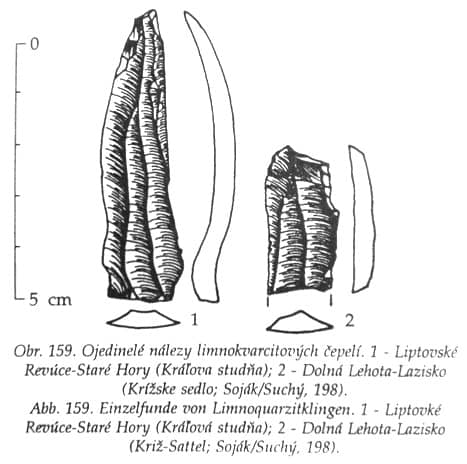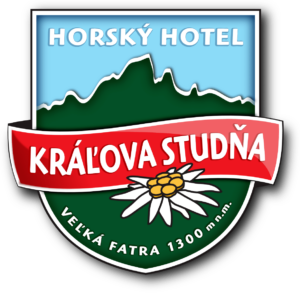Documents of settlement of Veľká Fatra and Low Tatras
Marián Soják – Anton Suchý
Archaeological finds from the mountainous regions of Slovakia are few and mostly discovered by chance. These also include the modest documents of the prehistoric settlement of the landscape of the Fatran-Tatra region. The finds are stored in the Archaeological Institute of the Slovak Republic – Spišská Nová Ves workplace.

1. Liptovské Revúce (Ružomberok district) and Staré Hory (Banská Bystrica district), location of Kráľova studňa, SE from elevation 1384.0, accidental find of A. Suchý Jr., prehistoric (Eneolithic to Early Bronze Age). A rare find of a chipped stone artifact (Fig. 159:1) comes from the SW part of Veľká Fatra (Bralná Fatra). Finder A. Suchý Jr. he found it on the hiking trail leading from the location in question to Krížna (elevation 1574.0), about 50-70 m SE from elevation 1384.0 at Kráľová studna. Typologically, it is a regular and significantly curved blade from the edge of a single-base core with a retouched striking surface and an indicated cone (bulb). The determination of the raw material is not clear. It is most likely cream-colored limnoquartzite (length 58 mm, width 14-16 mm, depth 4-5 mm).
2. Dolná Lehota (Brezno district) and Lazisko (Liptovský Mikuláš district), location Krížske sedlo, SW from elevation 1774.5, accidental find A. Suchý st., prehistoric (Eneolithic to Early Bronze Age). A rare chipped tool (fig. 159: 2) was found by A. Suchý st. on the hiking trail (red sign) called Cesta hrdinov SNP near elevation 1774.5, which is at the junction between elevations 1936.7 (Kotliská) and 1873.0 (Poľana). It is the terminal part of the blade with a partially retouched right edge, made of gray-brown limnoquartzite (length 29.5 mm, width 14.5 mm, height 4.5 mm). The circumstances of the discovery of both artefacts do not allow us to comment on their interpretation. There can be several reasons why the stone chipped industry came to the place of discovery. Findings of undated mining objects and monuments related to them (copper cakes, slag, threshing floors, etc.) from the survey of A. Točík r. 1971 in the village of Staré Hory indicate one of the possible alternatives (Find report of AÚ SAV Nitra 2207, 2208 and 5627/1971). Whether it is proof of the presence of prehistoric prospectors and miners or shepherds, or hunters exploring the high terrain, both finds testify to the perfect knowledge of mountain regions by the populations of that time. The typology of the artifacts speaks for their most probable classification in the Eneolithic to Early Bronze Age. From the cadastral territory of the village of Lazisko, finds of sherds of the Púchov culture from the location of Žiarec (stored in the Liptovský múzem Ružomberok; Nálezová správa AÚ SAV Nitra 227/1950) and a numerous inventory of finds from the Late Roman period, the late Roman period, and the beginnings of the migration of peoples from the fortified area are known from younger periods. Zvon location (Discovery report of AÚ SAV Nitra 14 630/2001).





